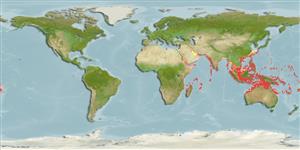Environment: milieu / climate zone / depth range / distribution range
Écologie
marin récifal; profondeur 0 - 100 m (Ref. 58652). Tropical; 30°N - 23°S
Indo-Pacific: Red Sea to South Africa (Ref. 35918) and to the Tuamoto Islands, north to the Ryukyu Islands, south to New Caledonia. Formerly known as Vulnerable (A1d+2cd) (Y. Sadovy) but now listed as Endangered in IUCN 2004.
Length at first maturity / Taille / Poids / Âge
Maturity: Lm ?, range 52 - ? cm
Max length : 229 cm SL mâle / non sexé; (Ref. 9823); common length : 60.0 cm TL mâle / non sexé; (Ref. 5450); poids max. publié: 191.0 kg (Ref. 9710); âge max. reporté: 32 années (Ref. 51676)
Épines dorsales (Total) : 9; Rayons mous dorsaux (Total) : 10; Épines anales: 3; Rayons mous anaux: 8. This species is distinguished by the following characters: body deep, its depth 2.2-2.7 times in standard length; dorsal profile of head straight to above eye, then becoming convex; adults develop a large hump on forehead that can protrude anterior to eye; anterior tip of head forming an acute angle; jaws and lips prominent, 2 strong canines anteriorly in each jaw; no enlarged tooth present of rear of upper jaw; D IX,10, continuous; A III,8; dorsal and anal fins of adults very pointed, reaching well posterior to caudal-fin base; pelvic fins of small fish reaching anus, extending beyond anal-fin origin in large adults; pectoral fins with ii unbranched and 10 branched rays; caudal fin rounded; lateral line interrupted below posterior portion of dorsal-fin base, with a total of 22-23 pored scales; scales reaching well onto bases of dorsal and anal fins; scales in front of dorsal fin extending forward to above centre of eye; cheek and opercle scaly; lower jaw without scales. Colour of body olive to green with a vertical dark bar on each scale above and behind pectoral fins; head of adults blue-green to blue with highly irregular undulating yellowish lines; 2 black lines extending posteriorly from eye. Juvenile coloration lighter to white with dark scale bars and prominent black lines extending posteriorly from eyes, as well as 2 lines extending diagonally up and back from eye and 2 diagonally downward on snout in front of eye (Ref. 9823).
Adults inhabit steep outer reef slopes, channel slopes, and lagoon reefs (Ref. 1602). They are benthopelagic at 2-60 m (Ref. 58302). They are usually solitary but may occur in pairs. Juveniles are encountered in coral-rich areas of lagoon reefs, where staghorn Acropora corals abound (Ref. 1602) and also in algae reefs or seagrasses (Ref. 48636, 41878). Adults rove across the reefs by day and rest in reef caves and under coral ledges at night (Ref. 31343). Primary food are mollusks, fishes, sea urchins, crustaceans, and other invertebrates. They are one of the few predators of toxic animals such as sea hares, boxfishes and crown-of-thorns starfish (Ref. 1602). They are oviparous with distinct pairing during breeding (Ref. 205). They are sold in Hong Kong live fish markets (Ref. 27253). This species is captured by hook-and-line and by spear, and is occasionally marketed for food. Juveniles are occasionally seen in the aquarium trade (Ref. 9823). Minimum depth reported taken from Ref. 128797.
Life cycle and mating behavior
Maturité | Reproduction | Frai | Œufs | Fécondité | Larves
Oviparous, distinct pairing during breeding (Ref. 205). Also Ref. 103751.
Randall, J.E., G.R. Allen and R.C. Steene, 1990. Fishes of the Great Barrier Reef and Coral Sea. University of Hawaii Press, Honolulu, Hawaii. 506 p. (Ref. 2334)
Statut dans la liste rouge de l'IUCN (Ref. 130435: Version 2024-1)
Menace pour l'homme
Reports of ciguatera poisoning (Ref. 5374)
Utilisations par l'homme
Pêcheries: intérêt commercial mineur; Aquaculture: commercial; pêche sportive: oui; Aquarium: Commercial
Outils
Articles particuliers
Télécharger en XML
Sources Internet
Estimates based on models
Preferred temperature (Ref.
123201): 24.9 - 28.8, mean 27.5 °C (based on 580 cells).
Phylogenetic diversity index (Ref.
82804): PD
50 = 0.5078 [Uniqueness, from 0.5 = low to 2.0 = high].
Bayesian length-weight: a=0.01479 (0.01140 - 0.01919), b=2.97 (2.89 - 3.05), in cm total length, based on LWR estimates for this species (Ref.
93245).
Niveau trophique (Ref.
69278): 4.0 ±0.61 se; based on food items.
Generation time: 27.5 ( na - na) years. Estimated as median ln(3)/K based on 2
growth studies.
Résilience (Ref.
120179): Faible, temps minimum de doublement de population : 4,5 à 14 années (tm = 5-7; tmax = 32).
Fishing Vulnerability (Ref.
59153): High to very high vulnerability (74 of 100).
Nutrients (Ref.
124155): Calcium = 12.1 [5.8, 27.5] mg/100g; Iron = 0.416 [0.172, 0.952] mg/100g; Protein = 18.1 [13.7, 21.4] %; Omega3 = 0.0801 [, ] g/100g; Selenium = 63.5 [27.0, 158.4] μg/100g; VitaminA = 100 [16, 448] μg/100g; Zinc = 1.77 [1.00, 3.02] mg/100g (wet weight); based on
nutrient studies.
